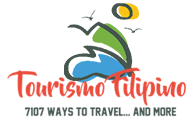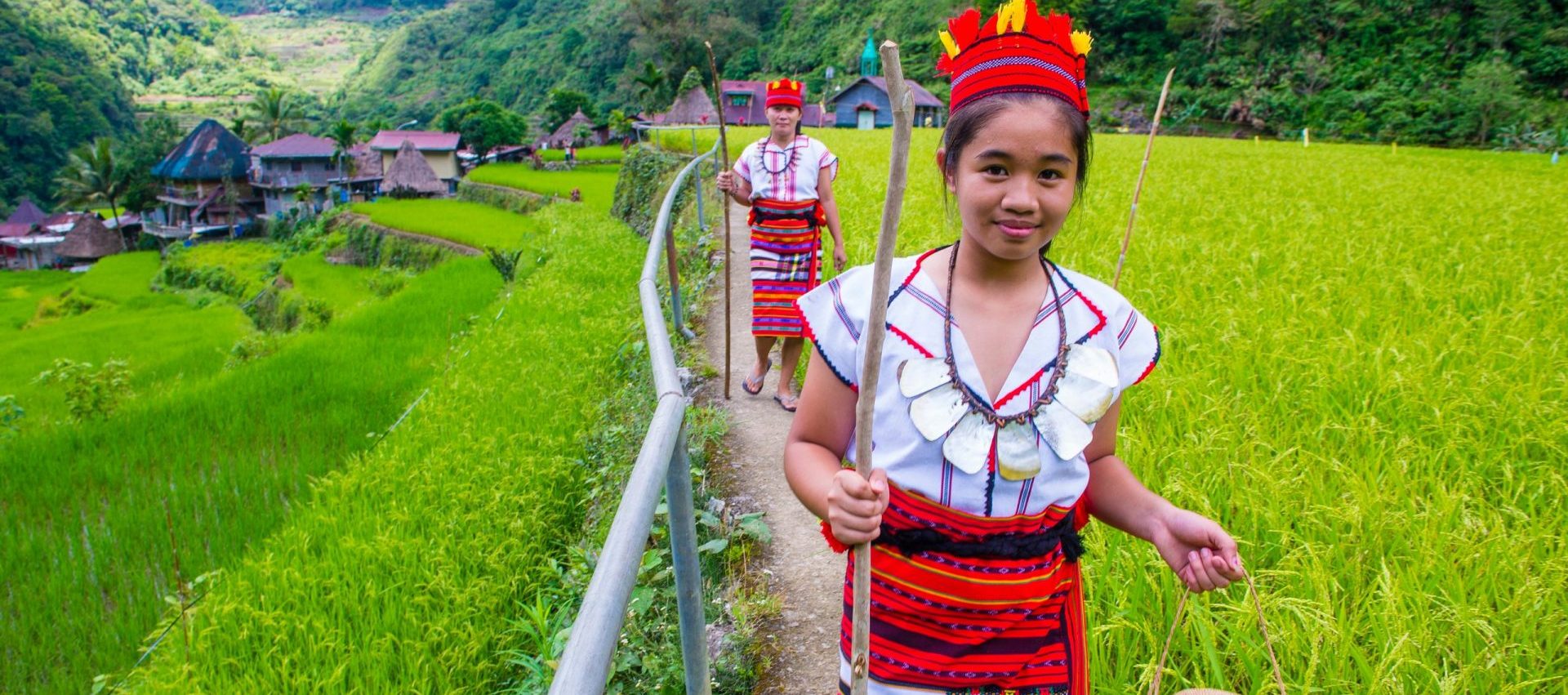Banaue - The Amazing Rice Terraces
World Heritage Site.
The rice terraces of Banaue are part of the Ifugao rice terraces, which are included in UNESCO’s World Heritage List (The Rice Terraces of the Cordilleras, Bataad, Mayoyao, and Bangaan in Banaue). These terraces are considered one of the globally significant agricultural heritage sites and have been selected as one of the country’s two “Green” global sites based on world travelers and tour guides’ recommendations. They have also received an international historic award from the American Society of Civil Engineers.
The place is known as the “Eighth Wonder of the World” according to the country’s tourism offices and local marketers. This remarkable structure highlights the engineering ingenuity of the Ifugao tribe, and some argue that it was built by their ancient ancestors more than two thousand years ago.
>> Banaue Tour – 4 days and 3 nights (recommended!)
>>Bataad’s Rice Terraces – An Enchanting and Extraordinary Place – Click here.
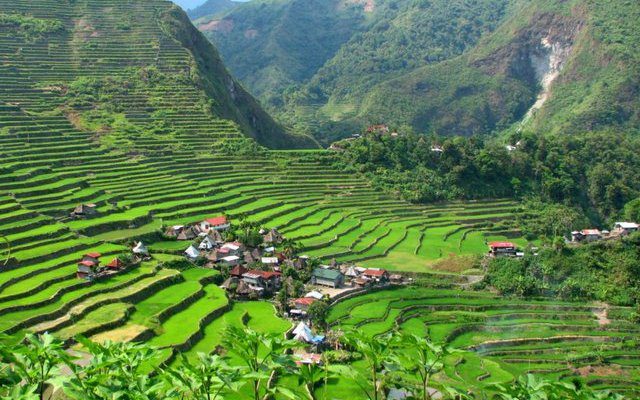
An ancient irrigation system still in operation today.
The tiered rice terraces are irrigated using a complex system of streams and springs designed in the form of terraces. Combined with the unique flow pattern of the terraces, the streams are channeled into waterways, forming an essential and inseparable part of the ecological system of the mountain, enabling the Ifugao people to cultivate rice at altitudes exceeding a thousand meters above sea level. The terraces were built using primitive tools and the keen observational skills and creativity of the Ifugao people. Indeed, when measuring the vertical distance from the summit to the base, the rice terraces can reach impressive heights, even surpassing some of the tallest and sturdiest structures in the world.
Direction to Banaue
You can reach Banaue from Manila by bus, with a travel time that can take up to about ten hours. Ohayami Trans offers a direct bus route from Manila to Banaue. It’s recommended to check the travel schedule and make arrangements in advance, as there are limited buses traveling to and from Banaue. Another option is to take a private tour where a driver picks you up from your hotel in Manila and returns you to Manila at the end of the tour, which typically lasts for 3-4 days. The quickest and preferred way for many travelers is by taking a round-trip flight to an airport near Banaue and then traveling to the hotel/airport from there.
>> Flights to Banaue (and other transportation options)
In Banaue, there is a wide selection of shops selling souvenirs, especially hand-carved wooden sculptures, which the Ifugao people are known for. You can purchase a variety of items, including “bulul” (idol statues) and benches belonging to the highest social status of the Ifugao people called “the agabi.”
Unique attractions in the area
If you’re looking to try something unique, you can experience riding on wooden scooters called “tustos.” These are practical scooters handcrafted from full oak wood and can be rented at an affordable price. The tustos itself can reach speeds of up to 80 km/h on steep slopes. It is lightweight and easy to assemble and disassemble. Additionally, it has wooden wheels padded with rubber coating and foot pedals for foot braking while riding, as the scooting action of these scooters is tailored for downhill travel. For uphill travel, you can use your feet, similar to the comedic “Flintstones” effect in the famous television series.”
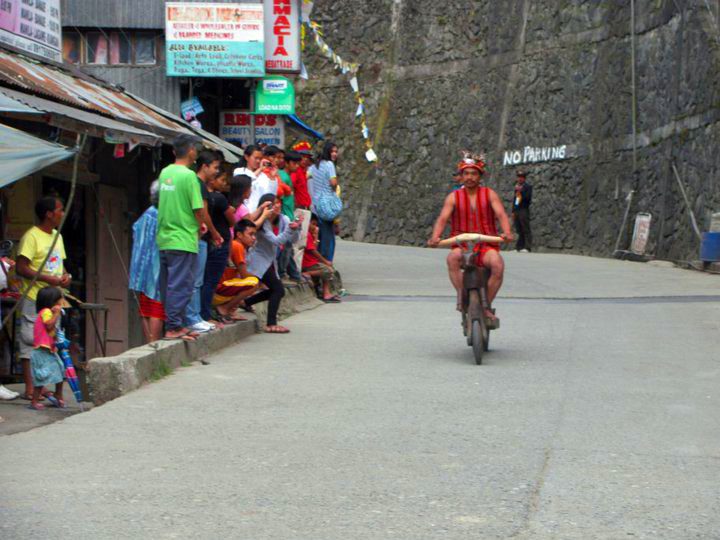
The most beautiful view…
The best way to enjoy a breathtaking view of the stunning rice fields is, of course, from the highest point. So, after a few body-stretching exercises, embark on your journey with a trek to the highest viewpoints of the Banaue mountains, which takes about an hour’s walk.
There are numerous viewpoints, especially along the trail on the way to the town of Bontoc. Your efforts at the mountaintop will reward you with a panoramic view of the enchanting rice terraces of Ifugao.
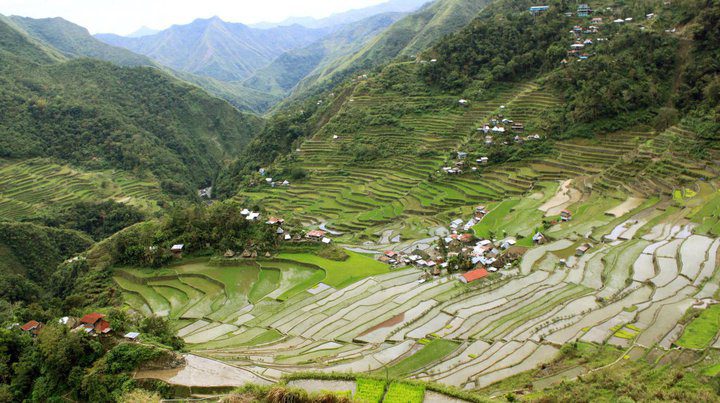
Attractions and Activities Unique to Banaue
Just when you thought you had seen everything there is to see, two guys appear, gliding on “wakeskates,” surfing on the Banaue rice terraces and enjoying like never before.
When a video surfaced on the internet showing pioneers of the water sport “wakeskating,” Brian Grubb from the USA and Dominik Preisner from Germany, speeding on the Banaue rice terraces using wakeskates, an immediate uproar ensued in several quarters, claiming that this ancient wonder, over a thousand years old, had been disrespected and desecrated. The issue became a heated discussion on various social media platforms, appeared on local and international news channels, and was covered in newspapers, with many from the population expressing their concerns on the matter.
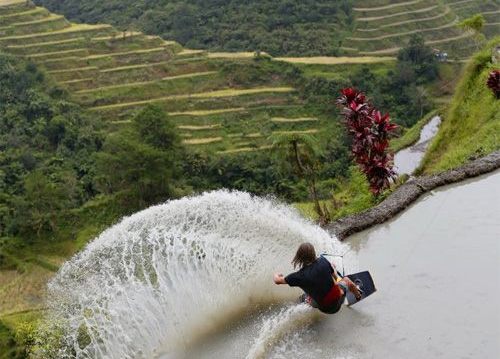
Image from abs-cbn philippines
“Wakeskating” is a relatively new addition to the category of extreme sports. It is a water-based sport with similarities to skateboarding, utilizing similar principles and techniques, but the maneuvers and tricks are performed on water instead of on skate ramps. Brian Grubb is one of the well-known athletes and pioneers in this sport. He claims that they have traveled the world in search of unique locations to train and practice their chosen sport.
The question arises: What is the absolute stance or outcome on this matter? Were some of the rice terraces indeed affected by the athletes’ actions? Did they disrespect the Ifugao people and their leaders? According to Jerry Difolug, the mayor of Banaue, the answer is no. Difolug made sure in advance that none of the terraces would be harmed during the activities. The elders of the Ifugao tribe, known as “Mumbaki” (religious and healing leaders of the tribe), who perform their traditional and religious dances in the rice terraces, gave their approval after consulting with them regarding the athletes’ activities. They even conducted tribal ceremonies to ensure the safety of the daring athletes and the well-being of the rice fields, which included the sacrifice of chickens and the consumption of rice wine.

